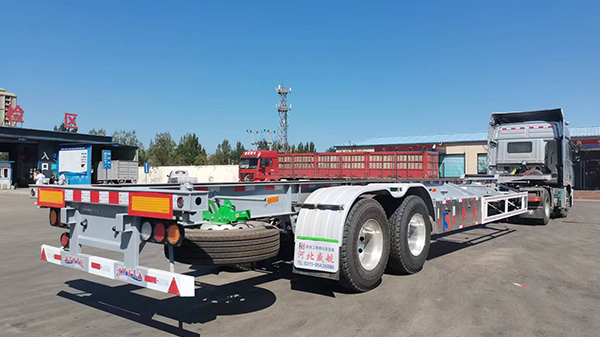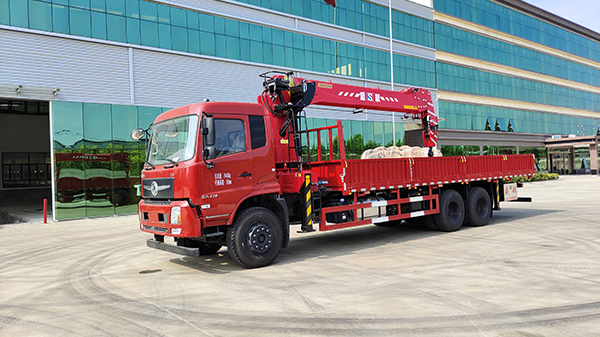Related Articles - NACFE report identifies methods to reduce freight emissions in intermodal - Peterbilt expands collision mitigation features for Model 579 - Vipar Heavy Duty donates to charities at Impact Conference
Every truck suspension option comes with its own unique performance trade-offs. The best choice requires an understanding of how the trade-offs match up to your application requirements. The right suspension can maintain a tractor-trailer’s road handling and ride quality, and helps minimize the amount of jarring (bumps, vibrations) for improved load-carrying ability. This protects both the trailer and the freight inside from being damaged, and also cushions the chassis from road shock, enabling the driver to steer. The right suspension also maintains the proper axle spacing and alignment. Highway Crane Trucks

To help you decide what will work best for you, let’s walk through the basics of the two most common suspensions used in trucking: air ride and leaf spring.
Air ride uses a variety of valves, airlines and air-spring bags in place of steel suspension. The flexible air-spring bags are made from a woven and rubber-like material. The air supplied to the air-ride suspension uses the same air compressor and air reservoir as a truck’s braking system (See Figure 1).
The supplied air pressurizes the air-spring bags, creating a spring-like motion that raises the chassis from the axle. Air suspensions are more complicated but often provide a smoother ride and keep sensitive cargo for getting damaged. Using air ride can also make unhooking trailers much easier by using the dump valve to lower the truck enough to pull away from the trailer. But if air ride is used on a dump application you must release air pressure before lifting the bed due to the fact that the dump bed at full height will sway back and forth and could tip over. Leaf spring systems
Spring suspensions use semi-elliptic leaf springs to cushion a load from road shock. As one of the most commonly used suspensions, spring ride consists of several layers of flexible steel strips referred to as a “leaf pack.”
The strips are joined together to act as a single unit. The long and narrow arch-shaped plates are attached to the frame of a trailer, resting above the trailer’s axle. (See Figure 2)
Spring suspensions are sometimes a harsher ride but are often less expensive to repair due to their simple nature. Spring suspensions are generally used for more heavy duty applications where ride isn’t as important and the cargo is not as sensitive (construction, refuse, off road etc.)
With all of the choices on the market, finding the best suspension for your operation can be a daunting task. It’s best to seek expert advice rather than go it alone. Ask for input from a respected sales professional with specific expertise in suspension applications. Make sure they know exactly under what conditions the truck will be operating, and inform them what you are hoping to spend on operational cost. Lastly, try to get feedback from other fleet or maintenance managers who do similar work—ask them what they use and why.
This article was contributed by Kurt Schneider, technical editor for Mitchell 1’s Commercial Vehicle Group. Additional tips for repair and maintenance of Class 4-8 trucks can be found in the Mitchell 1 ShopConnection Truck blog.
Volvo Trucks places safety and sustainability at the forefront of every decision we make. It is our responsibility at Volvo Trucks to protect and preserve the finite resources of our planet. While making our business environmentally and financially sustainable, we will, together with our customers, leave a better world to our future generations.
FTR’s numbers have Class 8 orders for October at 28,000 units.
FTR's numbers have Class 8 orders for October at 28,000 units, down 10% from September and 35% from October 2022. FTR says that the weaker comparisons were well within expectations given the weakness in freight transportation and the ongoing normalization of equipment markets following exceptional demand in 2022. Class 8 orders totaled 255,000 units over the past 12 months. The annualized rate over the past six months has been 233,000 units. The annualized rate over the past three months has been much stronger than the 12-month total, but that result is simply a function of the recent opening of 2024 production slots, FTR says.
These vehicles will be utilized to pick up parts from various supplier locations in the Pacific Northwest and deliver them to DTNA’s consolidation center in Portland.
Peterbilt presented TMC Transportation, Inc. with the keys to the Model 579 at the Denton plant.
Now we come to the answer to the question that started it all: How fuel efficient can a new truck driver be? Related Articles – ACT Research: Used truck prices stabilize in October – Five truck trend takeaways from November – FTR Shippers Conditions Index shows positive readings in September as diesel prices fall As
The used Class 8 average retail sale price fell 1% month-over-month and 25% year-over-year.
Year-to-date, cumulative new business volume was up 0.7% compared to 2022.
October net orders, at 35,300 units, were 26% higher year-over-year, and 4,000 units more than were booked in September.
The outlook is for consistently negative readings for the TCI in 2024.
The battle to earn the CDL is over, but the fight to crown a fuel efficiency champion is just getting started.

White Dump Trailer Truck industry content for fleet owners and managers